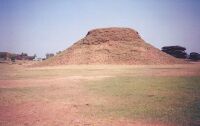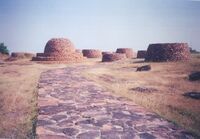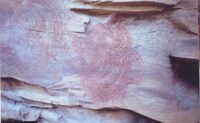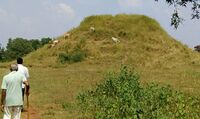Deorkothar
| Author:Laxman Burdak, IFS (R) |
Deorkothar (देउर कोठार) (Deur Kothar) is a site of archaeological importance in Rewa district of Madhya Pradesh. It is known for its Buddhist stupas and was discovered in 1982.
Location
It is situated about 5 km north-west of village Katra in Rewa district at a distance of 75 km from Rewa on Rewa – Allahabad Road. Deorkothar village is located at Longitude 81°40' East and Latitude 24°56' North in Tyonthar tehsil of Rewa district.
Discovery of Ashokan Stupa at Deorkothar
The remains of a fallen stone railing were found close to stupa-1. The carvings seem to represent an earlier stage than those at Sanchi and Bharhut. It is possible that The Deur Kothar stupa may have been established by the Maurya king Ashoka in the 3rd century BCE. [1]
In the ancient times, the site was located on the Dakshinapatha (Southern Trade Route) running east-west from Patliputra (Patna) to Pratishthana in Maharashtra through Central India. Being situated centrally amongst the famous Buddhist places like Sanchi, Sagar, Kaushambi and Sarnath, Deur Kothar used to be visited by Bhuddhist monks frequently.
The discovery and excavations
P.K. Mishra (Archaeological Survey of India) discovered Deorkothar in 1982 along with Ajit Singh, sarpanch of village Barhat. It was declared a monument of national importance in 1988 by the Govt of India and is being preserved and conserved by Archaeological Survey of India, Bhopal.
Realising the importance of the site, and its likely international bearing on Buddhism, the Archaeological Survey of India decided to carry out extensive, but controlled, excavations at the site. The excavations were started at the site in 1999 and continued up to 2000. The site is marked by four stupa mounds out of which two stupas No. 1 and 2 were subjected to archaeological excavations. There are remnants of 40 stupas made of stones or bricks. In the area around there are rocks with old rock paintings. Some rocks have inscriptions in Brahmi language.
The Buddhist firmament is abuzz with word of amazing discoveries at the newly excavated site of Deorkothar in Madhya Pradesh, India. Situated on the ancient Dakshinapath (southern trade route), Deorkothar lies between Bharhut and Sanchi, two major Buddhist centers established in the third century BC. It is surprising that Alexander Cunningham, the nineteenth-century doyen of Indian archaeology who did extensive work in the area, missed the site. Excavations at Deorkothar, which seems to predate the late Mauryan-Sunga period (fourth through first centuries B.C.), when most early stupa (temple) complexes were built, promise to throw light on the genesis and spread of Buddhism in Central India, providing missing links in the history of Buddhist art and architecture.
Deorkothar inscription
Also recovered pieces of a pillar with a six-line inscription in Brahmi, the precursor to modern Indian alphabets, the earliest examples of which date to the rule of the Mauryan empire, Ashoka (273 BC-232 BC). The six line Brahmi inscription on the Deorkothar pillar is given in the table - transliterated into Devanagari script.
|
भ ग व तो बु ध उ त र मि त्रो उ त र मि त्र स अ भ ड् भ ड् स आ ते वा सि ना दि नु उ पा स क स आ ते वा सि स व ज य स व ध म द वे न के क डी के न ब स ति ये उ स पि तो भं भो आ आ च रि ये न क सि |
| Deur Kothar Inscription[2] |
In brief, the translation of the aforesaid inscription at Deokothar is as follows:
- "The inscription opens up with Lord Buddha as first line of the inscription clearly suggests. The gist of the inscription, pertains to the erection and dedication of stone pillar at place by Upasaka and his disciplines in memory of Buddha, the enlightened one."
The inscription speaks about an Acharya, named Dharmadeva (धर्मदेव), and his three disciplines - Uttarmitra (उत्तर्मित्र), Bhadra (भद्र) and Upasaka (उपासक), who used to reside in the monastery. They installed this pillar, dedicating it to the Buddha.
Architecture
The Deorkothar complex boasts four brick stupas, the most ever found at a site of this period. The varying sizes of bricks used in construction point to an early date. Such motifs as twirling lotus, conical lotus bud, and a simple flower pot on a three-tiered pedestal-the carving of which foreshadows early Buddhist art, can be seen on the railing posts of the largest brick stupa, which rises to a height of nearly 30 feet. The stencil-cut effect of the friezes, along with their simple ornamentation and the paucity of human and animal figures, suggests these are early attempts at stone railing art. It would therefore seem that the stupa at Deorkothar was built before the famous early free-standing stupa at Sanchi.
The site of Deorkothar also comprises monasteries, a water channel system, an ancient pathway, and 30 stone stupas, many of which contained sherds of high quality northern black polished ware, the pottery of everyday use between 700 and 300 B.C. Such sherds are absent from Sanchi, further indicating that Deorkothar predates that site.
Dotting the site of Deorkothar are 63 rock-shelters, many with art dating to the first century B.C., that were likely used by monks for meditation. One painting depicts a stupa and a tree surrounded by a railing. Others show social or hunting scenes; men, women, and animals; weapons; and designs.
Although the pillar bears the trademark Mauryan polish, it is made not of the Chunar sandstone characteristic of Ashokan sculpture, but of local sandstone. Also found at the site were pottery, pieces of stone caskets and bangles with exquisite polish, some copper fragments, a lead strip coiled ear stud, iron nails and clamps, few coins (one punch-marked), pieces of terra-cotta toys, and beads. Worthy of particular mention are several pieces of Mauryan polished chattra (the multi-tiered "umbrella" at the top of a stupa) with evidence of radial ribs. To the west of the main stupa, iron slag, a lump of iron ore, and white nodules of lime indicate the presence of an iron-smelting furnace nearby.
Active trade centre
The discovery of pieces of terracotta toys, beads, ear stud and coins hints that the site was an active centre of trade. Perhaps, the genesis of this pilgrimage site occurred amidst a vibrant mercantile community.
Curiously, the ancient tradition of lime technology noticed from some Harappan and post-Harappan sites besides Kausambi has now been observed at Deorkothar. The excavations have thrown significant light on the art and technological excellence of Deorkothar.
Subjected to destruction
The ancient Buddhist text Divy Adanam speaks of the death and destruction brought about by Pushyamitra Sunga, who ruled in the first quarter of the second century B.C., in a bid to glorify Hinduism. During his reign, Buddhist monuments were wantonly destroyed. This Mauryan pillar lay in more than fifty pieces directly on the flagstone flooring along with the balustrades broken into smithereens. Even the chhatra (umbrella) lay in the rubble of systematic annihilation. The devastation continued on the brick body of the stupa which is understood by the brickbat debris uniformly overlying the fragments of the balustrade. This wanton destruction has been temporarily assigned to the first quarter of the 2nd century BC. Although archaeological evidence is meager in this regard, it seems likely that the Deorkothar stupa was destroyed as a result of Pushyamitra Sunga's fanaticism. The exposed remains at Deorkothar bear evidence of deliberate destruction datable to his reign. The three-tiered railing is damaged; railing pillars lie, broken to smithereens, on stone flooring. Twenty pieces of pillar have been recovered, each fragment itself fractured. The site offers no indication of natural destruction.
Stupa 'older than' Sanchi's now cattle grazing ground
It looks like a mound or a small hill, overgrown with grass that cattle roam around munching. Children run up and down the knoll, and one would walk past it without realising that what lies beneath is one of the treasures of India's past - a Mauryan-era Stupa that may predate the the one at Sanchi.
Dating back to the 3rd century BC, this stupa is not a secret but a glaring example of apathy. For over four decades, it has been left looking like an unkempt hill.
It pains Dr Mishra, 66, who retired as a regional director of ASI eastern region, as his dream of seeing the Deorkothar stupa restored to its glory remains unfulfilled. [3]
ASI prepares plans to conserve Stupa ignored for four decade
On the day TOI published a report on how a Mauryan-era Buddhist stupa has been left to turn into a cattle grazing ground, the director general of Archaeological Survey of India sought a report on the neglected heritage in Deorkothar village of Rewa district. [4]
Connection with Jat clans
Deorkothar seems to have connection with the ancient Jat clans: Deu and Kothar, which needs further research. Both these gotras have originated from the Nagavanshi rulers. This area has been under the Nagavanshi rulers. We find mention in Jat history that Deu (देऊ) gotra originated from Devaka (देवक) (दउवक) of Nagavansh. [5]
From the records of Bharhut we find that the Nagavanshis were exterminated in this area and as such there is no trace of Deu/Deur/Kothar clan people in present times. But we have habitation names after Deu which indicates their presence in these areas ruled by Nagavanshis in the past. Such villages are:
- Deu (देऊ) is village in Nagaur tahsil and district in Rajasthan.
- Deu (देऊ) is village in Kheenvsar tahsil in Nagaur district in Rajasthan.
- Deu (देऊ) is village in Amarpatan tahsil in Satna district in Madhya Pradesh.
- Deur named Villages is in Dhule District of Maharashtra.
Jat Gotras Namesake
- Deu + Kothar = Deorkothar = Deur Kothar) is a site of archaeological importance in Rewa district of Madhya Pradesh. It is known for its Buddhist stupas and was discovered in 1982.
See also
Source
- Dainik Bhaskar, Satna, 13 September 2006
- P.K. Mishra: Deorkothar (Barhat), Rewa, A Unique, Recently - Excavated Buddhist Site in Central India; Archaeological Survey of India, Bhopal.
External links
- DEORKOTHAR : A MILESTONE OF HISTORY, Dr. P.K. Mishra
- The Buddha Bounces Back By Eric Powell: DISCOVER Vol. 22 No. 07 | July 2001
- Times of India, Stupa 'older than' Sanchi's now cattle grazing ground, Amarjeet Singh, 12.06.2023
Notes
- ↑ "A History of Ancient and Early Medieval India: From the Stone Age to the 12th Century" by Upinder Singh, Pearson Education India, 2008,p.364
- ↑ P.K. Mishra: Deorkothar (Barhat), Rewa, A Unique, Recently - Excavated Buddhist Site in Central India; Archaeological Survey of India, Bhopal.
- ↑ Times of India, Stupa 'older than' Sanchi's now cattle grazing ground, Amarjeet Singh, 12.06.2023
- ↑ Times of India, ASI prepares plans to conserve Stupapa ignored for four decades, Amarjeet Singh, 13.06.2023
- ↑ Dr Mahendra Singh Arya etc,: Ādhunik Jat Itihas, Agra 1998 p.256
Back to Jats in Buddhism



